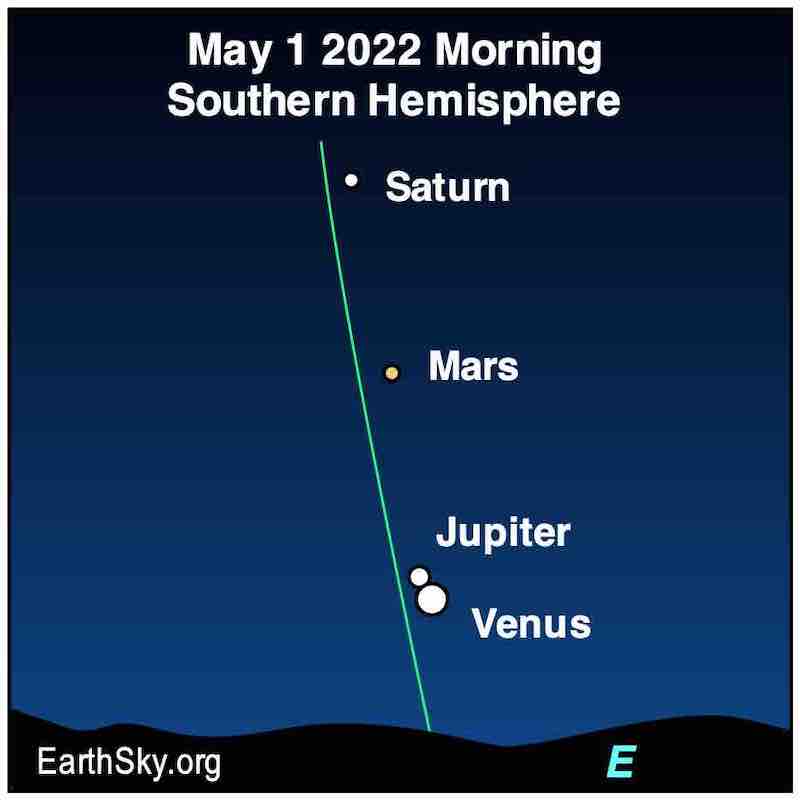
Venus and Jupiter are getting closer every morning as they head toward their April 30, 2022 conjunction.
When and where to watch for the Venus and Jupiter conjunction: Look in the sunrise direction to see bright Jupiter, dazzling Venus, and fainter Mars and Saturn. You’ll see Venus and Jupiter inch closer every day.
Closest conjunction will take place at 19 UTC on April 30. So the mornings of April 30 and May 1 will feature the two worlds as closest in our sky. At conjunction, Venus will be 0.2 degrees – less than a full moon diameter – south of Jupiter.
Note: Start watching now to enjoy the bright pair, as they creep closer together in the east before sunrise. And keep watching after May 1 to see the planets separate again. You’ll understand why the ancients called them wanderers.
Venus and Jupiter on April 30 and May 1

At 19 UTC on April 30, Venus will be 0.2 degrees south of Jupiter. For observers in the Americas, they will be separated by the same angular distance as a full moon, about 1/2 degree. Binoculars help separate these two worlds in their bright planetary glare. Even though Venus and Jupiter appear next to each other in the sky, they are really nowhere near each other in space. They are separated by 430 million miles (690 million km), or nearly five times the Earth–sun distance!
How close will they be each morning?*
April 24: Venus and Jupiter are 5.9 degrees apart
April 25: Venus and Jupiter are 5 degrees apart
April 26: Venus and Jupiter are 4.1 degrees apart
April 27: Venus and Jupiter are 3.2 degrees apart
April 28: Venus and Jupiter are 2.3 degrees apart
April 29: Venus and Jupiter are 1.4 degrees apart
April 30: Venus and Jupiter are 0.5 degrees apart
May 1: Venus and Jupiter are 0.6 degrees apart
*Times are in EDT and based on Abrams Planetarium Sky Calendar
The view from the Southern Hemisphere
The ecliptic, or path of the planets through our sky, is oriented more vertically in the sky for those in the Southern Hemisphere in spring. Therefore, their view will differ from the view to the north.

The view through binoculars
To get the most out of this conjunction, you might want to try a pair of binoculars. Binoculars help separate these two worlds in their bright planetary glare.

Venus and Jupiter conjunction near the moon mornings of April 26 and 27
Before Jupiter and Venus are at the peak of their conjunction, you can spot a waning crescent moon passing the planets. On April 27, the moon will lie below the brightest planets.

Venus and Jupiter conjunction
It’s a special treat when the two brightest planets, Venus and Jupiter, appear stunningly close together in what astronomers call a conjunction. Astronomers use that word when two objects pass one another in right ascension. But the term conjunction is also commonly used in a more informal way, indicating that two objects appear near one another on the dome of our sky.
Even though Venus and Jupiter appear next to each other in the sky, they are really nowhere near each other in space. Venus is the second planet outward from our sun. Jupiter is the 5th planet. At conjunction, the two worlds are separated by 430 million miles (692 million km), or nearly five times the Earth–sun distance!
Bright Jupiter climbs quickly in the morning twilight and heads toward brilliant Venus in the last week of April 2022. On the morning of April 27, the two planets are joined by the waxing moon for an eye-catching scene. Three mornings later, Jupiter and Venus will meet in a conjunction, visually nearly bumping into each other. Because of the glare from both planets, many people will see them merge into one very bright glow. The morning of May 1, continues the show, but with the positions of the planets reversed.
Note that Venus and Jupiter are not the only planets on display these mornings. Nearby, Mars and Saturn complete this fine planetary roundup.
Bottom line: During the Venus and Jupiter conjunction, the two planets will appear a scant 1/2 degree or less apart in our sky just before sunrise. You can also spot Mars and Saturn.











